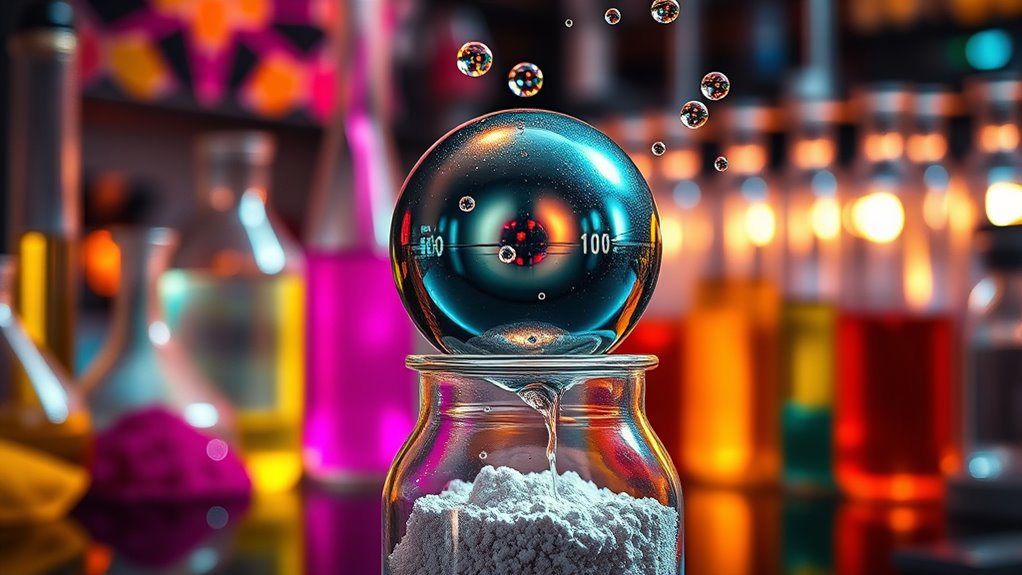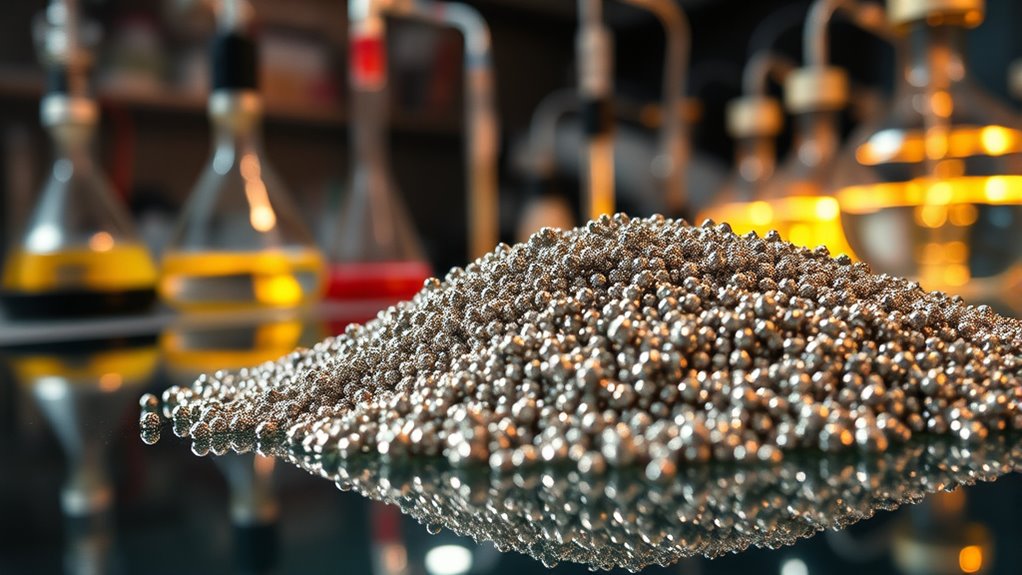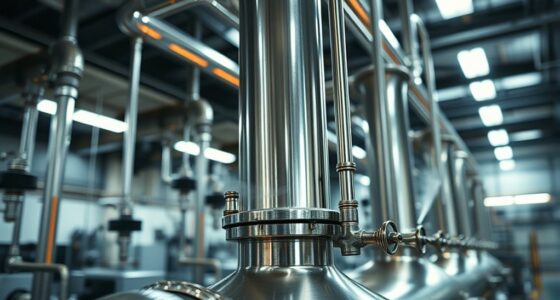Catalysts are substances that speed up chemical reactions by lowering the activation energy needed to start them, without being consumed in the process. They work by providing alternative pathways through surface interactions, where reactants adsorb, react, and then release as products. Different types include homogeneous, heterogeneous, enzymatic, and acid-base catalysts, each with unique roles. Understanding how catalysts improve efficiency and function will reveal their essential importance in industry and nature alike.
Key Takeaways
- Catalysts are substances that speed up chemical reactions without being consumed themselves.
- They work by lowering the activation energy needed for reactions, often via surface interactions.
- Catalysts can be homogeneous, heterogeneous, or enzymatic, each operating in different ways.
- They form temporary bonds with reactants, creating intermediates that facilitate easier transformation.
- Catalysts are vital in industry and nature, improving efficiency, reducing energy use, and supporting biological processes.
Understanding What Catalysts Are

Have you ever wondered how some reactions happen faster than others? That’s where catalysts come in. They’re substances that boost reaction rates without being used up themselves. Catalysts work by lowering the activation energy needed for a reaction to start, making it easier for reactants to transform into products.
They do this by forming temporary bonds with reactants, creating alternative pathways that speed up the process. Importantly, catalysts only increase the rate; they never slow it down or get consumed. They facilitate various reactions, including acid–base and redox processes, often through interactions like coordination complexes. Catalysts can be in different forms, such as solids, liquids, or gases, depending on the reaction conditions. Because of their ability to be reused and their efficiency, catalysts are essential in industries like energy, pharmaceuticals, and manufacturing. Their presence accelerates reactions, making processes more economical and sustainable, especially in industrial applications.
Different Types of Catalysts and Their Roles

Catalysts can be classified based on their phase relative to the reactants, which influences how they interact and function in a reaction. Homogeneous catalysts share the same phase as reactants, usually in solution, allowing direct molecular interaction and precise control. They often facilitate reactions by forming temporary bonds with reactants, increasing the reaction rate. Heterogeneous catalysts are in a different phase, often solids, providing surfaces where gases or liquids react. Enzymatic catalysts are biological proteins that speed up reactions with high specificity, operating under mild conditions. Industrial processes favor heterogeneous catalysts because they’re easy to separate and reuse. Acid-base catalysts work by donating or accepting protons to accelerate reactions like hydrolysis or esterification. Positive catalysts lower activation energy, while negative catalysts slow reactions. Promoters boost catalyst activity, and inhibitors deactivate catalysts by blocking active sites.
The Step-by-Step Mechanism of Catalytic Action

Understanding the step-by-step mechanism of catalytic action reveals how catalysts facilitate reactions efficiently. First, reactants adsorb onto the catalyst’s surface, where they dissociate into simpler components. These intermediates form on the surface, lowering the energy barrier for the reaction. Resources and Tools can provide additional insights into the importance of surface interactions and intermediates in catalysis. As the reaction progresses, products desorb from the surface, freeing sites for new reactants. Throughout this process, the catalyst remains unchanged, regenerating itself at the end to catalyze subsequent reactions. Many catalytic reactions involve a rate-determining step followed by faster steps, with multiple intermediates sometimes forming along the way. By providing an alternative pathway with lower activation energy, the catalyst speeds up the reaction without being consumed, ensuring continuous efficiency.
This sequence highlights how catalysts harness surface interactions and intermediates to accelerate chemical transformations.
Factors That Influence Catalyst Performance

The performance of a catalyst depends on multiple interconnected factors that influence its activity and selectivity. You should consider catalyst composition and structure, as the type of active metals, shape, size, and support materials determine how well it facilitates reactions. Surface area and the distribution of active sites directly impact efficiency, with larger surface areas offering more interaction points. Reaction conditions like temperature, pressure, and reactant concentration also play crucial roles, affecting reaction rates and equilibrium. Catalyst surface properties, including porosity, promoters, and poisons, influence accessibility and activity. Particle size and electronic structure affect adsorption and durability. Additionally, the presence of cybersecurity vulnerabilities can impact catalyst monitoring systems and safety protocols, emphasizing the importance of secure digital infrastructure. Lastly, environmental factors such as solvents, impurities, and external fields can enhance or hinder catalyst performance over time.
Why Catalysts Are Essential in Industry and Nature

Factors that influence catalyst performance directly impact their effectiveness in both industrial processes and natural systems. You rely on catalysts to boost efficiency by speeding up reactions, which lowers energy use and increases output. They help maintain high product quality by ensuring consistent conditions and reducing unwanted by-products. Additionally, ongoing research into divorce party decorations and empowerment gifts highlights the importance of celebrating new beginnings and personal growth during transitional periods. In industry, catalysts are essential for refining fuels, producing plastics, and synthesizing pharmaceuticals, making processes more cost-effective and sustainable. They also play an integral role in environmental protection, such as reducing vehicle emissions and minimizing toxic waste. In nature, enzymes act as catalysts, enabling life-sustaining reactions at mild conditions. Without catalysts, many essential processes in industry and biology would be slow, costly, or impossible, highlighting their indispensable role in advancing technology and supporting life itself.
Frequently Asked Questions
How Do Catalysts Affect Reaction Equilibrium?
You might wonder how catalysts influence reaction equilibrium. They don’t change the position of equilibrium; instead, they speed up both forward and reverse reactions equally by lowering activation energy.
This means you reach equilibrium faster without altering the amount of reactants or products present at equilibrium.
Catalysts are vital in industrial processes because they reduce reaction time and energy consumption, making reactions more efficient without shifting the balance of the reaction itself.
Can Catalysts Be Used in Multiple Reactions Simultaneously?
Imagine juggling flames and glass, balancing multiple delicate reactions at once. Yes, catalysts can be used in multiple reactions simultaneously, but it’s a tightrope walk. You need precise control of conditions and compatibility among catalysts.
When done right, it’s like orchestrating a symphony, enhancing efficiency and yields across processes. This approach is crucial in industry and research, turning complex tasks into harmonious, productive outcomes.
What Are the Environmental Impacts of Catalyst Disposal?
You should be aware that improper catalyst disposal can harm the environment. Metals from catalysts may leach into soil and water, contaminating ecosystems and affecting plant and aquatic life.
Toxic residues and heavy metals pose serious risks if not managed properly. Recycling catalysts helps prevent these issues by conserving resources, reducing pollution, and promoting sustainable practices.
Ultimately, recycling catalysts protects your environment from long-term damage.
How Are New Catalysts Developed and Tested?
Did you know over 80% of new catalysts are first developed in labs before scaling up? You’ll start by exploring innovative materials like single-atom catalysts or novel compounds.
Then, use computer simulations and AI to forecast their behavior. You test their activity, stability, and selectivity in various reactors, incorporating advanced monitoring tools.
This process guarantees catalysts are efficient, durable, and aligned with sustainability goals before they reach industrial production.
Do Catalysts Work Differently in Biological Versus Chemical Reactions?
You might wonder if catalysts work differently in biological versus chemical reactions. They do, in some ways.
Biological catalysts, or enzymes, are highly specific and operate efficiently at body temperatures and conditions, lowering activation energy precisely for specific reactions.
Chemical catalysts, on the other hand, can be less specific and tolerate a broader range of temperatures and pressures.
Both types speed up reactions by lowering activation energy, but their mechanisms and conditions differ.
Conclusion
Remember, a catalyst might not change the outcome but speeds up the process, making things happen faster and more efficiently. In your pursuits, understanding how catalysts work can help you innovate and solve problems more effectively. Just like the saying goes, “A little spark can start a great fire,” even small changes with the right catalyst can lead to big results. Embrace the power of catalysts, and let them help you achieve more with less effort.









